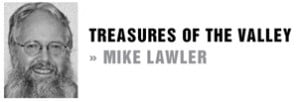Our community recently lost one of its pioneer citizens, Charles Bausback. But fortunately, part of Charles will live on, as he left us a huge legacy in his personal memories.
When first I met Charles years ago, he seemed to have nearly every day of his past on the tip of his tongue, and each of those stories he told had amazing outcomes – dramatic, comedic or ironic. Some of his stories were absolutely fantastic, and frankly hard to believe, but as time went on and I learned more of the history of the valley, every one of those amazing tales was borne out as true. I have learned more about the Crescenta Valley and Los Angeles in the 20th century from Charles, than from any other source. Charles was a historical society’s dream. He had an amazing gift – vivid, clear memories of every significant event in his rich life, and the ability to entertain with a good story.
For instance, he remembered his family’s trek out here from the east coast in 1928, traveling on the Lincoln Highway. They had navigate deep patches of mud (the highway was only paved in the cities) and then build a raft to take their car across a river swollen with floodwater. His family was moving here because of young Charles’ severe asthma, and as he told us, the Crescenta Valley was rated by the US Health Department as having the best air quality in America.
His dad ran a restaurant at the fledgling Burbank Airport, then a hangout for the greats of aviation, and in turn a hangout for young Charles. He related being taken for a demo flight with Captain Eddie Rickenbacker. Rickenbacker was trying to demonstrate, by taking a small child up, that flying was absolutely safe, all to make a sale of a new airplane to a nervous customer. He remembered that aviation great Roscoe Turner was a regular there, and was often in company with a lion cub that he traveled with to promote Gilmore Gasoline. Charles would be left to walk the young lion around the airport on a leash, which included some disastrous visits to his dad’s restaurant’s kitchen.
We heard about his family’s survival of the disastrous flood of New Year’s Eve 1934, and how they felt the ground shake as the flood approached. They were cut off from the outside world, heard their names on the radio in a list of the dead, and Charles had to hike out to report himself and his family alive. He told us of returning to his house to find a group of women looters fighting over his mother’s clothes.
We learned from Charles that Hindenburg Park, once a famous German-American cultural center that attracted thousands from all over California, was right here in the Crescenta Valley. He and his family, being of German descent, were regulars at the many celebrations held there. We learned from him that the park attendees segregated themselves, one side for the genteel Northern Germans, where they sipped wine and listened to classical music, and the other for the earthier Southern Germans, where the sounds of oompah bands and the hiss of beer barrels being tapped were dominant. We heard how the American Nazi’s that attended the Hindenburg Park events- remember this was before WWII – would hire a plane to fly over the Crescenta Valley, throwing out thousands of pro-Nazi leaflets, a common practice I later learned was called “snowstorming”.
Amazing stories form an amazing lifetime.
When my wife and I first became involved in leadership roles in the Historical Society, she predicted, and accurately, that we would have our hearts broken. She knew that we would fall in love with our older members, and that they would leave us behind. We would be deeply sad, and lonelier. But we would be rich in memories – memories of the departed, plus the memories of the past that they had left us. And so it is with Charles. We loved him, and he gave us a valuable treasure: his memories.

